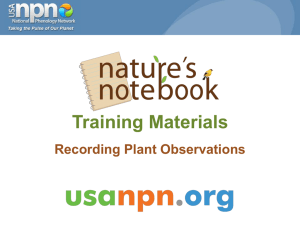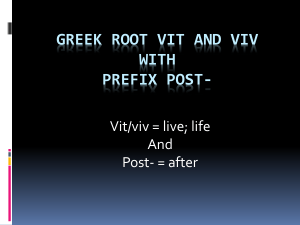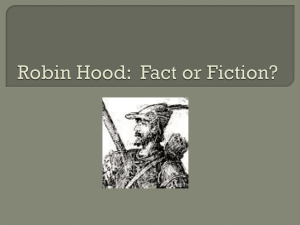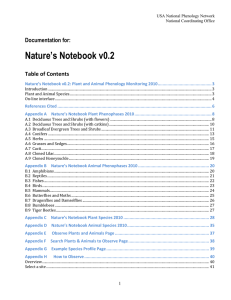A quick example: American robin
advertisement
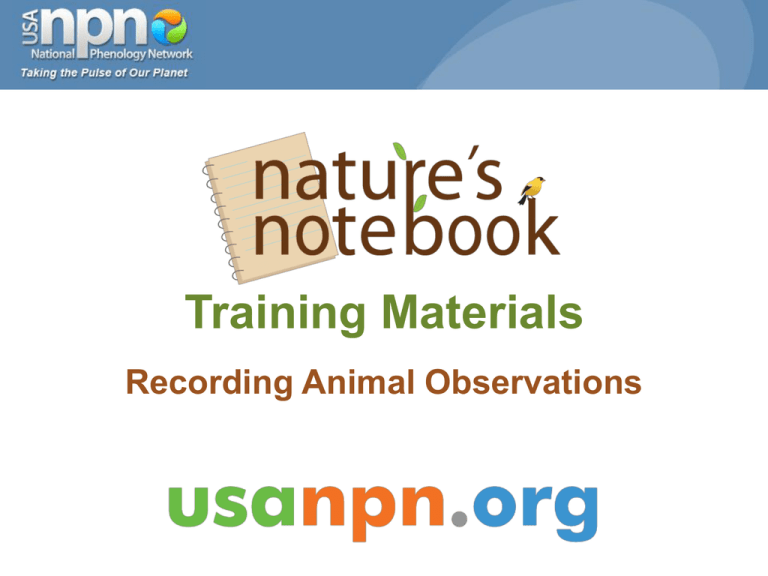
Training Materials Recording Animal Observations 1. Select a site 2. Select plant and animal species 3. Select individual plants 4. Mark your site and plants 5. Record your observations of animals 6. Record your observations of plants 7. Report your data online www.usanpn.org/participate/guidelines 2 • Plants: repeat observations of the same individual plants • Animals: create a checklist for your site, look and listen for all species each time you visit 3 Observation considerations • • • • Phenophases to observe Frequency of observations Special considerations Site visit details 4 Observation considerations 5 6 Observing animals • Walking a single line through site • Stationary at a single point • Area search: multiple passes through site 7 Phenophases to observe Check animal profile page: http://www.usanpn.org/species_search 8 9 10 11 12 What to look for and record • Yes (Y) – if the phenophase is occurring • No (N) – if the phenophase is not occurring • Uncertain (?) – if you are not certain whether you saw or heard that species or that phenophase • Do not record anything if you did not check for this phenophase 13 What to look for and record • Yes (Y) – if the phenophase is occurring • No (N) – if the phenophase is not occurring • Uncertain (?) – if you are not certain whether you saw or heard that species or that phenophase • Do not record anything if you did not check for this phenophase 14 What to look for and record • Yes (Y) – if the phenophase is occurring • No (N) – if the phenophase is not occurring • Uncertain (?) – if you are not certain whether you saw or heard that species or that phenophase • Do not record anything if you did not check for this phenophase 15 What to look for and record • Yes (Y) – if the phenophase is occurring • No (N) – if the phenophase is not occurring • Uncertain (?) – if you are not certain whether you saw or heard that species or that phenophase • Do not record anything if you did not check for this phenophase 16 What to look for and record • Yes (Y) – if the phenophase is occurring • No (N) – if the phenophase is not occurring • Uncertain (?) – if you are not certain whether you saw or heard that species or that phenophase • Do not record anything if you did not check for this phenophase 17 What to look for and record • Yes (Y) – if the phenophase is occurring • No (N) – if the phenophase is not occurring • Uncertain (?) – if you are not certain whether you saw or heard that species or that phenophase • Do not record anything if you did not check for this phenophase 18 19 A quick example: American robin 20 21 A quick example: American robin 22 A quick example: American robin 23 2 24 A quick example: American robin 25 A quick example: American robin 26 2 1 1 27 A quick example: American robin 28 2 1 29 30 31 32 33 34 35 Robin Goldfinch Black-capped chickadee Gopher snake 36 4/8/10 Robin Goldfinch Black-capped chickadee Gopher snake 37 4/8/10 4/15/10 5/1/10 Robin Goldfinch Black-capped chickadee Gopher snake 39 40 Cover Sheet 41 42 43 44 45 46 47 48 49 50 51 52 • W = walked a single line through site • S = stationary at a single point • A = area search through site 53 54 56 57 5 5 5 5 During each site visit: • Summarize animals seen and heard on the Animal Checklist • Document any phenophases seen or heard for animals on your checklist on individual Animal Phenophase Datasheets • Document site visit details on the Cover Sheet 59 Bringing it all together: Another quick example • American robin • Black-capped chickadee • Bumblebee Photo:Trounce/Wikimedia Commons 60 Bringing it all together: Another quick example On your site visit, you see: • One robin flying through the site • Two bumblebees visiting flowers And you hear: • One robin singing 61 4/8/10 Robin Black-capped chickadee Bumblebee 62 2 1 1 63 3/1/11 2 2 64 5/5/10 5/5/10 3 5/5/10 3 • W = walked a single line through site • S = stationary at a single point • A = area search through site 67 5/5/10 3 5/5/10 2 3 5/5/10 4 2 3 Another example… • American robin • Black-capped chickadee • Bumblebee Photo:Trounce/Wikimedia Commons 71 Frequency of observations • As often as possible • At least once a week • All observations are valuable! 72 Time of day of observations • Convenient for you • Consistently • For species on Nature’s Notebook list, during the day 73 What if I missed a phenophase? • Make a note of it in the comments section of your data form 3/10/11 2 1 2 1 74 Nest built between 3/1/11 and 3/10/11 What if a phenophase isn’t occurring? • Continue to watch • Make a note of it in the comments section of your data form 2 1 11/10/11 2 1 75 No robins seen mating this year 75 What if I never see the animals on my list? • Often you will not see them • Sometimes you will never see them • This information is very valuable 76 Keep looking for a phenophase, even after it has ended 77 Keep looking for a phenophase, even after it has ended 78 79
